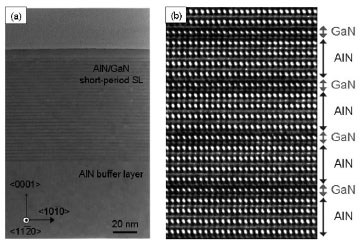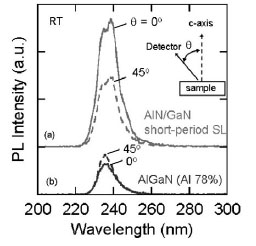@
Materials Science Laboratory
@AlGaN alloys are promising materials for ultraviolet (UV) light-emitting
diodes (LEDs) with emission wavelengths ranging from 210 nm (AlN) in deep-UV
to 365 nm (GaN) in near-UV regions. At present, the emission efficiency
of deep-UV LEDs is much lower than that of near-UV LEDs. One intrinsic
reason for the lower emission efficiency is attributed to the valence band
structure [1]. For GaN the topmost valence band is the heavy hole (HH)
band. The transition between the conduction band (CB) and HH band is allowed
for electric field perpendicular to the c-axis (EŪc), and the emission
intensity is therefore strong along the c-axis (from C-plane). On the contrary,
for AlN the topmost valence band is the crystal-field split-off (CH) band.
The transition between the CB and CH band is allowed for electric field
parallel to the c-axis (E||c), and the emission intensity is therefore
weak along the c-axis (from C-plane). Because the LEDs are fabricated with
the C-plane orientation, which is suitable for high-quality growth, the
emission intensity is intrinsically low for deep-UV LEDs using high-Al-content
AlGaN. Recently, we demonstrated that AlN/GaN short-period superlattices
(SLs) show stronger deep-UV light emission from the C-plane than the AlGaN
alloys [2].
@Transmission electron microscopy (TEM) images of AlN/GaN short-period
SLs are shown in Fig. 1. The GaN well thickness was 0.48 nm (1.8 monolayesr)
and the AlN barrier thickness was 1.82 nm (7.3 monolayers). The growth
of the SL structure with abrupt interfaces between AlN and GaN was confirmed.
The emission properties of the AlN/GaN short-period SLs were characterized
by photoluminescence (PL). As the GaN well thickness decreased from 2.5
to 0.9 monolayers, the emission wavelength decreased from 275.8 to 236.9
nm due to the quantum size effect. To investigate the polarization property,
angle-dependent PL was carried out (Fig. 2). For an AlGaN alloy, the emission
along the c-axis (Ę = 0º) was weak because of the E||c polarization.
On the contrary, for the AlN/GaN short-period SLs, the emission along the
c-axis was strong. This is because the quantized energy level for holes
originates from the HH band of GaN and therefore the transition between
the electron and hole quantized energy levels is allowed for EŪc. Due to
the different polarization properties, the AlN/GaN shortperiod SL shows
four times higher emission intensity than the AlGaN alloy. We also fabricated
a deep-UV LED with AlN/GaN short-period SLs as an emission layer and confirmed
strong deep-UV light emission from C-plane.
[1] Y. Taniyasu and M. Kasu, Appl. Phys. Lett. 90 (2007) 261911.
[2] Y. Taniyasu and M. Kasu, Appl. Phys. Lett. 99 (2011) 251112.
@
 |
@ |  |
||||
|
|